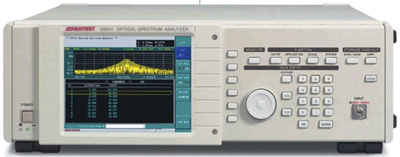
|
|
The Advantest Q8341 is an optical spectrum analyzer for visible radiation with a wavelength range of 350 nm to 1000 nm. It uses a Fourier spectrum system with a Michelson interferometer which allows it to measure coherence. With its narrow wavelength resolution of 0.01 nm, the Q8341 is very effective for the evaluation of not only CD/DVD laser diodes, but also for blue-violet laser diodes. In addition, the built-in He-Ne laser acts as a wavelength reference to ensure a high wavelength measurement accuracy of ±0.01nm. Finally, with its fast 0.5 s measurement speed, the Q8341 is ideal for evaluating temperature characteristics of system components. Specifications. Wavelength Measurement range: 350 to 1000 nm. Wavelength Measurement Accuracy Standard: ±0.05 nm. Wavelength Measurement Resolution Standard: 0.05 nm. Level Input sensitivity: –50 dBm or less (350 to 1000 nm), –55 dBm or less (400 to 900 nm). Maximum input power: +10 dBm. Level Accuracy: ±1.0 dB (780nm, Input level of –10 dBm ). Level Scale: 0.2, 0.5, 1.0, 2.0, 5.0, 10 dB/div and Linear. Dynamic range: 30 dB or more. Coherence Max. analysis length Standard: 10.3 mm. Input return loss: 30 dB. Measurement time CW Mode Standard: 2 s or less. Optical input Connector: FC type. Applicable fiber: 50/125 GI fiber. I/O interface: GPIB (IEEE 488.2), Ethernet (10/100 Base), VGA output, USB port, PS/2 Mouse. Display: 6.5 inch color LCD (640 x 480 dots). Options. 70, built-in high-speed sweep and coherence length extension.
|